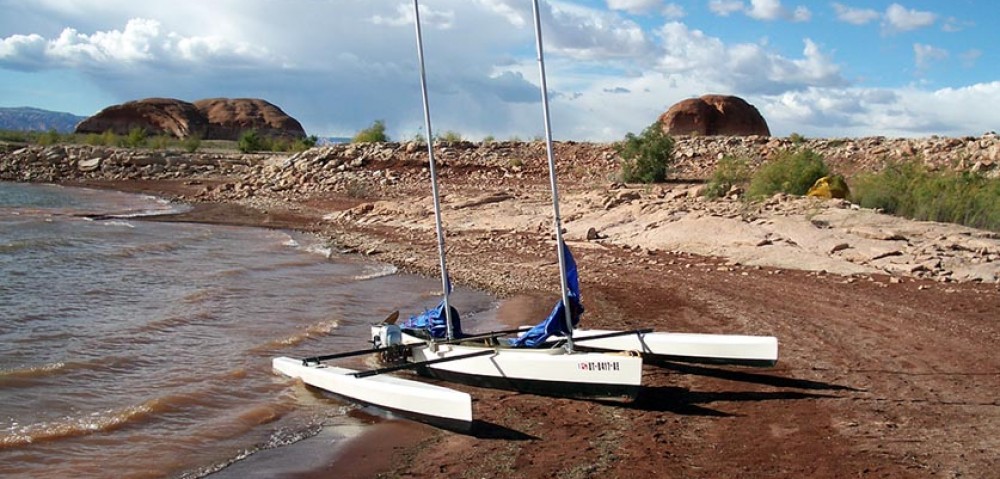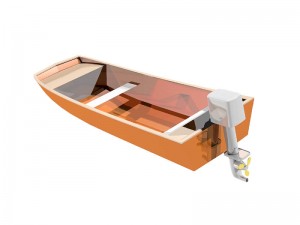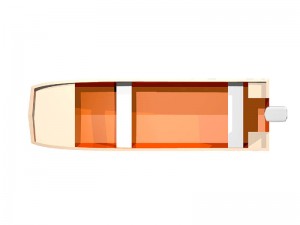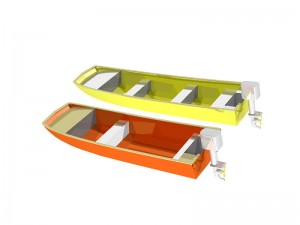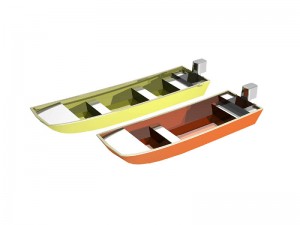A Superior Weapon for the Outdoorsman
One day I was driving around the industrial area near my boat shop and happened to pass the local power boat center. Sitting out front of the store were two, rather homely looking aluminum skiffs that are typically used around Utah to hunt ducks and geese and perform general boating duties for outdoorsmen. I had never really taken a good look at the type before as I had more pressing matters in front of me trying to finish the build on a sailboat. For some reason, I pulled over to just get an idea as to how these metal boats went together and to understand the shapes that went into the hull. Most folks refer to the form as a Jonboat, although I’ve also seen it as Johnsboat and Flat-Bottomed Skiff, by various other sources. Jim Michalak’s version of this simple skiff has been a real hit with homebuilders and there’s a bunch of good reasons why that’s so. They’re easy to build, provide hours of trouble free operation with the simplest of outboards and can do just about anything you could ask for a utility boat. I went home that night and dialed-up the design software and started fooling around with a few ideas as to how I would design one of these boats for my portfolio. The result is that I came up with two versions that are very much alike except that one is a bit longer than the other for added carrying capacity is. Swamper
Rather than design a straight, flat-bottomed hull, I chose to give the Swamper a very slight Vee shape for the underwater parts. This gives a somewhat better ride through choppy conditions such as those you would find on any small lake when the wind comes up. If you’ve ever ridden in a flat bottom hull while pushing through small waves and experienced the slamming effect that comes with a flat surface as it hits the oncoming wave, you already know what I mean by this. The overall length of the boat is 15’5” and the overall beam is just a shade over 55”. The height is 22” along the sides with the gunnel rising from that height in a soft curve, yielding a bow that is only 28.5” above the floor of the boat. The main components come out of seven total sheets of plywood. The two bottom panels are from 3/8” material and the rest of the boat is from ¼” stock with the exception of the transom which is built from two layers of 3/8” ply. The boat is epoxy filleted and taped on the inside and completely covered in epoxy glass on the outside surfaces. The build style is simple, stitch and glue with one butt joint connection to be made to get the full-length hull panels. There is a full-length stringer at gunnel level and it is covered with a four-inch wide cap rail completely around the boat with the exception of the transom mounting location for the engine.
The flotation chambers can be easily adapted to provide on-board storage if the builder installs watertight hatches or inspection ports. I feel that the optimal, outboard engine size for this boat would be in the 15-20HP range. It will work just fine with a smaller engine, though, as the boat is quite light. I’m sure somebody will hang something bigger than this, but I’m not recommending it. The Swamper is perfect for fishing; hunting work related tasks on the water and just plain old fooling around. It can go into some pretty thin water with its draft of just under 7” at 650 pounds of displacement and can easily be setup with oars and a removable center seat for human powered applications. If you live out in the country and have a good relationship with the local Sheriff, the Swamper will fit snugly between the wheel wells of the standard American pickup. With the tailgate down, you’ll have five feet of boat hanging out, but it is doable. Again, I’m not recommending the practice; just letting you know it can be done… if you’re so inclined. Normal transport would be with a lightweight trailer, which would allow you to keep the outboard on the boat for short distances. A 15 Hp outboard doesn’t weight too much, but I prefer to see them removed from the transom for transport over long distances. This boat is very much like the Swamper with virtually the same lines. The biggest differences are the length at 18’, the ability of the boat to carry more weight and the addition of an extra, installed seat with its enclosed flotation volume. With an extra layer of ¼” plywood on the transom, this boat can easily handle a 30-40 HP motor. The costs to build the Swamp King are slightly greater due to the added plywood for the increased length and some additional trim, structural material as well as extra epoxy and glass. Even though these are simple boats, they are capable of providing years of wonderful service to the owner/builder with only very minor maintenance. If you have a teenage son or daughter who likes to enjoy outdoor activities with you, this boat would make for a terrific joint project over the winter. Either the Swamper or the Swamp King would make an excellent first boat to hand down when one of them gets old enough to have a boat of their own. Chris Ostlind |
